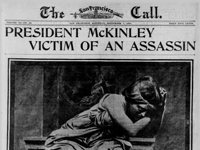This is the second of two articles on “Setting Standards”, about the Library of Congress involvement in three key standards formats. The previous article was published in May and contained an overview of Office Open XML and PDF/A. The following is an overview of the JPEG 2000 image format.

Page image from “Chronicling America”, The San Francisco Call, September 7, 1901.
At the Library of Congress, many digitized images are added to online collections every year. While this work dramatically increases access to the Library’s collections, it presents challenges for both presenting and storing this ever expanding amount of digitized information. The image compression standard JPEG 2000 (ISO/IEC 15444-1:2000) was approved in 2000 and may go a long way towards meeting these challenges. The JPEG 2000 standard has since been adopted for a variety of Library of Congress digitization efforts, as well as those of many other cultural heritage institutions.
This new file format standard for digital images has improved on the original JPEG file format in several areas, allowing for such increased capabilities as reduced storage space requirements, and enhanced display and transfer options. As used for the Library’s digital collections, a typical JPEG 2000 “master” file is transformed into a much smaller JPEG file for viewing in a web browser. This preserves the image quality much better than simply compressing the JPEG file. In addition, the JPEG 2000 master files are small enough to be delivered to those users who want extremely high quality images for their own use.
Another advantage of JPEG 2000 is that it offers rich and flexible support for metadata, providing not only descriptions of the images, but information on the provenance, intellectual property and technical data relating to the image itself.
For the Library’s online collections, JPEG 2000 has been successfully used for large-scale map images from the Geography and Map Division. For these highly detailed images, JPEG 2000 is being used as the replacement for the older MrSID format as the standard for online access (view a sample map collection). The new JPEG standard is also used at the Library for newspaper and manuscript images where there is a particular need to zoom in on details and examine different portions of the image. JPEG 2000 is now being used as the standard for all images in the National Digital Newspaper Program’s “Chronicling America” site, a joint project of the Library and the National Endowment for the Humanities providing access to information and page images from a variety of historic newspapers.
Building on the above collection uses, the Library has recently entered into a collaboration with the Xerox Corporation to test the JPEG 2000 format for very large-scale digital collections. For this project, Xerox scientists will use as many as one million of the Library’s previously digitized images to create and test the management of a large scale image repository. Eventually, they will develop one, or possibly multiple, JPEG 2000 profiles describing how to use this format to best represent the Library’s digitized map and photographic content.
For technical information on JPEG 2000, visit the specific page on the Library’s Sustainable Digital Formats site.
